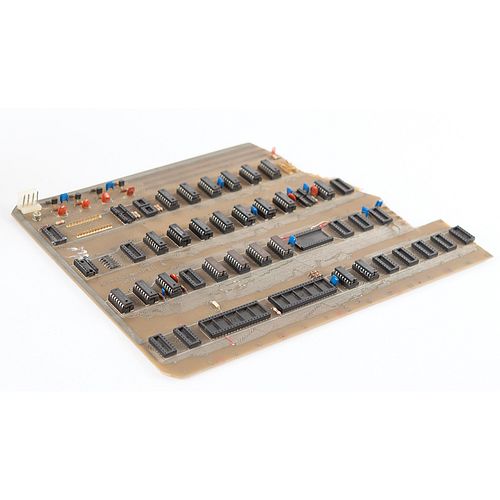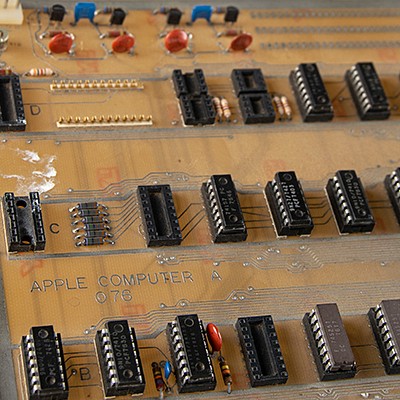Steve Jobs's Apple-1 Computer Prototype
Two ways to bid:
- Leave a max absentee bid and the platform will bid on your behalf up to your maximum bid during the live auction.
- Bid live during the auction and your bids will be submitted real-time to the auctioneer.
Bid Increments
| Price | Bid Increment |
|---|---|
| $0 | $5 |
| $50 | $10 |
| $200 | $25 |
| $500 | $50 |
About Auction
Aug 18, 2022
RR Auction support@rrauction.com
- Lot Description
Historic early prototype example of the computer that started it all—Steve Jobs's own Apple-1 Computer prototype, hand-soldered by Steve Wozniak on a unique "Apple Computer A" printed circuit board. In 1976, Jobs used this prototype to demonstrate the Apple-1 to Paul Terrell, owner of The Byte Shop in Mountain View, California, one of the first personal computer stores in the world. The demo resulted in Apple Computer's first big order and changed the course of the company—what Jobs and Woz had conceived as part of a $40 do-it-yourself kit for hobbyists became, at Terrell's request, a fully assembled personal computer to be sold at $666.66. Wozniak later placed Terrell's purchase order for fifty Apple-1s in perspective: 'That was the biggest single episode in all of the company's history. Nothing in subsequent years was so great and so unexpected.'
The board has been matched to Polaroid photographs taken by Paul Terrell in 1976 showing the prototype in use, first published by Time Magazine in 2012 and also covered by Achim Baqué of the Apple-1 Registry. This Apple-1 prototype, listed as #2 on the Apple-1 Registry and considered 'lost' until recently, was examined and authenticated in 2022 by Apple-1 expert Corey Cohen. It is accompanied by Cohen's notarized thirteen-page report.
This prototype resided on the 'Apple Garage' property for many years before being given by Steve Jobs to its current owner approximately 30 years ago. At that time, Jobs had been ousted from Apple and was looking forward to the promise of NeXT and Pixar. The board's present condition lends some insight into Jobs's judgment of it: he saw the prototype not as something to be enshrined, but as something to be repurposed. Several of the ICs have been plucked from their sockets, as have the microprocessor and other components, presumably for use on early production Apple-1 Computers.
The board appears to have been damaged by pressure on the upper right, resulting in a crack that runs from adjacent to the power supply area above D12 down through the bottom of the board to the right of A15. The missing piece is presumed to have been discarded, but can be reimagined thanks to Paul Terrell's photographs of the complete board. One of the distinguishing features of the "Apple Computer A" prototype was its use of three orange Sprague Atom capacitors, rather than the familiar 'Big Blue' capacitors used on the production Apple Computer 1.
Differences that remain between this prototype and production Apple-1s include the text on the left side of the board (the prototype reads, "Apple Computer A, © 76," where the production model reads, "Apple Computer 1, Palo Alto, Ca., Copyright 1976"), and the population of a clock circuit at the top left, which would have allowed the computer to run on Motorola 6800 or MOS 6501 processors. Although the production run of Apple-1 Computer PCBs retained this area (in a rectangle marked "6800 Only"), it was not populated. The production version of the Apple-1 shipped with a 6502 processor, which had an on-chip clock oscillator that rendered the external timing circuit unnecessary. This Apple-1 prototype also lacks the green protective coating and white silkscreen parts labeling found on production Apple-1s.
Another important characteristic of this prototype is that it appears to have been hand-soldered by Steve Wozniak, whose unusual 'three handed' technique—wire in one hand, soldering iron in the other, and solder held in his mouth—is evident in the tight 'bubbles' formed at the soldered connections. Several 'point to point' circuit corrections were made on the back of the prototype to make the system functional, and appropriate revisions were incorporated into the first production run of Apple-1 PCBs. The layout of the circuit traces on the prototype board therefore differs from that on the production PCB.
Few Apple artifacts could be considered as rare, early, or historic as this Apple-1 prototype, which spent many years on the 'Apple Garage' property—a site now entwined in the folklore of American business, where two unlikely heroes founded an empire. Moreover, it is the perfect embodiment of the symbiosis between Steve Jobs, Steve Wozniak, and Silicon Valley: the brilliant businessman, the electronics Einstein, and the infrastructure in which they thrived. Without Wozniak, Jobs had no product—he very nearly joined a company marketing balance scales made out of cardboard. Without Jobs, Woz had no market—he had already given away the Apple-1 design to members of the Homebrew Computer Club, and had little interest in exploiting it for profit. Without this prototype, and without Paul Terrell, the Apple-1 might have been 'just another computer kit.' It was the summer of '76, and a revolution was about to begin. - Shipping Info
-
Bidder is liable for shipping and handling and providing accurate information as to shipping or delivery locations and arranging for such. RR Auction is unable to combine purchases from other auctions or affiliates into one package for shipping purposes. Lots won will be shipped in a commercially reasonable time after payment in good funds for the merchandise and the shipping fees are received or credit extended, except when third-party shipment occurs. Bidder agrees that service and handling charges related to shipping items which are not pre-paid may be charged to a credit card on file with RR Auction. Successful international Bidders shall provide written shipping instructions, including specified Customs declarations, to RR Auction for any lots to be delivered outside of the United States. NOTE: Declaration value shall be the item’(s) hammer price and RR Auction shall use the correct harmonized code for the lot. Domestic Bidders on lots designated for third-party shipment must designate the common carrier, accept risk of loss, and prepay shipping costs.
-
- Buyer's Premium



 EUR
EUR CAD
CAD AUD
AUD GBP
GBP MXN
MXN HKD
HKD CNY
CNY MYR
MYR SEK
SEK SGD
SGD CHF
CHF THB
THB












